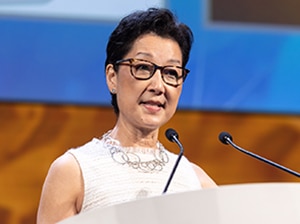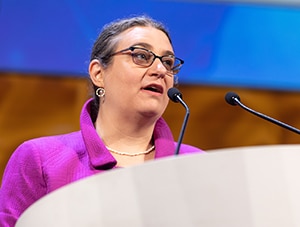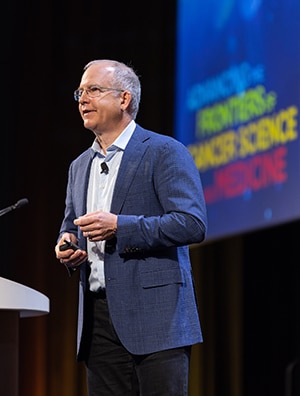AACR Annual Meeting 2023: The Many Aspects of Early Detection and Interception of Cancer
Early detection is key to improving outcomes from cancer. Shifting the focus even earlier in the natural history of the disease, research in the rapidly expanding field of cancer interception aims to characterize tumors at the earliest stages of development. Understanding the steps involved in the transition from pre-cancerous lesions to malignancy may help design strategies to thwart the process.
A plenary session at the AACR Annual Meeting 2023 gathered international experts to present the latest research on cellular and molecular carcinogenesis and discuss the importance of equitable access to testing and broad engagement of the population to realize the promise of early detection and interception of cancer.
Session chair Peter Kuhn, PhD, Dean’s Professor of Biological Sciences and professor of medicine, biomedical engineering, aerospace and mechanical engineering, and urology at the University of Southern California, compared interception of cancer to interception in football, where a proactive intervention is aimed at interfering with a cancer’s ability to develop and spread.
Somatic Mutations During Aging: Not All Mutations are Harmful
Presenter Phil H Jones, PhD, professor of cancer development at the University of Cambridge and senior group leader at Wellcome Sanger Institute, United Kingdom, discussed the role of somatic mutations in tumor formation.
Studies in multiple organs have demonstrated the presence of somatic mutant clones in all aging epithelial tissues. “As we age, we are progressively colonized by mutations,” Jones said, and added that these are predominantly cell-intrinsic, inevitable processes.

However, only a small fraction of these clones goes on to become tumors. Jones presented insights into this process from his team’s studies on the normal esophagus, focusing on the effects of mutations in the Notch1 and p53 genes.
While quite common in normal esophageal tissue by middle age, clones carrying Notch1 mutations are much rarer in esophageal cancer. In a mouse model, loss of Notch1 favored cell proliferation and clonal expansion, but did not promote tumor development. Notch1-mutant clones eliminated or slowed the growth of tumors that emerged after exposure to a carcinogen.
By contrast, p53 mutations are common both in the normal esophagus and in cancer, and drive both clonal expansion and tumor development, Jones said.
These observations challenge the assumption that a positively selected mutation that confers a proliferative advantage will also promote cancer, and support the notion that cell competition limits carcinogenesis. “The normal esophagus becomes a Darwinian battleground in which mutant clones fight for survival,” Jones said.
He proposed a model whereby the overall mutational landscape determines cancer risk based on the number of “good mutations,” like Notch1, and “bad mutations,” like p53, one carries.
Jones described a potential interception strategy that counteracts the effects of PIK3CA mutation, which acts both as clonal driver and oncogenic driver. In a mouse model, mutant PIK3CA led to a metabolic switch resulting in increased aerobic glycolysis. Jones showed that inhibiting aerobic glycolysis neutralized the clonal advantage of PIK3CA-mutant cells. If we can understand the phenotype of mutant clones, we might be able to devise strategies to neutralize the advantage of certain clones and curtail cancer risk, he argued.
Treating the Biology, Not the Diagnosis
E. Shelley Hwang, MD, MPH, Mary and Deryl Hart Distinguished Professor of Surgery, vice chair of research in the Department of Surgery, and professor of radiology at Duke Cancer Institute, used ductal carcinoma in situ (DCIS) of the breast to illustrate that cancer progression is a biologic continuum. She emphasized the importance of understanding when and how to intervene with early detection strategies to avoid overdiagnosis.
DCIS is a precancerous lesion mostly diagnosed through breast cancer screening. Because it is almost always treated, the rate and likelihood of progression to invasive cancer are unknown, Hwang said.

She argued that treating DCIS comes with a high health care cost but has not translated into a reduced incidence of invasive breast cancer, and that not all patients will benefit from treatment of their precancer.
According to Hwang, the key to providing appropriate management of patients with DCIS is to take into account the highly heterogeneous biological characteristics and outcomes of precancer.
The Breast Pre-cancer Atlas Center, of which Hwang is a principal investigator, is a collaborative effort to study DCIS progression. Using imaging, geospatial analysis, and single-cell molecular approaches, the researchers are studying the spatial relationship among cancer cells, the different cell neighborhoods in the tumor microenvironment, and the relationship between DCIS and adjacent invasive cancer tissue.
“This approach will allow us to have a better understanding of what genomic and molecular changes occur in association with invasive cancer progression,” Hwang said.
DCIS patients who are at low risk of invasive disease could be managed through active surveillance, instead of being treated with surgery and radiation, thus shifting the paradigm from reduction of recurrence to prevention of invasive disease, Hwang explained. “The goal is to treat the biology, not the diagnosis,” she said.
To test this approach and validate a previously identified molecular classifier for DCIS recurrence or progression, Hwang and colleagues have designed the phase III randomized COMET clinical study, which recruited patients with a new diagnosis of low-risk DCIS and randomized them to undergo surgery or active surveillance. The study endpoints are invasive disease development, survival, and patient-reported outcomes, including quality of life. Two other similar studies are being conducted globally, Hwang added.
She concluded that it is paramount to include patients in the discussion of how their precancer should be managed. “It is incumbent on us as the scientific community and the clinical community to provide patient education,” she said. “With all the exciting molecular testing out there, we should not lose sight of the fact that ultimately we want to make this [process] clinically useful for patients.”
Can We Forecast Cancer Like We Forecast the Weather?
Elana Judith Fertig, PhD, professor of oncology and director of the research program in Quantitative Sciences at Sidney Kimmel Comprehensive Cancer Center at Johns Hopkins University, presented data in support of the critical role of computational biology in enhancing research on tumor evolution.
“There has been an explosion of new high-throughput multi-omic technologies that are advancing cancer research,” said Fertig. “How do we distill all the large-scale data coming from these technologies into information that can guide therapeutic selection? We have to invent the fundamental mathematical methods that underlie the analysis of these data side by side with the technologies.”

Fertig’s research leverages a hybrid computational and experimental strategy to dissect the complexity of the pancreatic tumor microenvironment.
Her approach is influenced by her training in weather prediction and chaos theory: She seeks to apply the computational methods used for weather prediction to forecast cancer development, producing estimates of molecular and cellular states as the basis for developing precision interception strategies.
Fertig and colleagues are developing such models integrating spatial proteomics, single-cell technologies, and machine learning to uncover interactions between tumor cells and the microenvironment, understand how immune cells change in response to therapy, and predict efficacy of combination immunotherapies.
Fertig said that the use of mathematical tools will enable researchers to progress from precision medicine to predictive medicine and emphasized that convergence and team science are central to tumor biology and translational oncology.
The Potential of Cell-free DNA for Cancer Screening
The current screening tests save lives and reduce health care utilization, but leave room for improvement, said presenter Phillip G. Febbo, MD, chief medical officer at Illumina Inc., who reviewed the potential of cell-free DNA (cfDNA) tests for improving cancer outcomes and the importance of equitable access.
Single-cancer screening tests available for breast, lung, and colorectal cancer are very sensitive but have low specificity and low positive predicted value: About 1 in 20 individuals with a positive screening test will actually have cancer, Febbo explained. This means that the remaining 19 individuals with a positive test will undergo unnecessary further diagnostic workup.

In addition, the adoption rates for these tests remain low, and substantial disparities in cancer screening rates exist among racial and ethnic minorities and other medically underserved populations.
“We need more tools,” Febbo said, adding that no screening is currently available for most lethal cancers.
Multi-cancer early detection (MCED) tests use cfDNA to detect multiple types of cancer from a single blood draw. Since the cumulative probability of finding any cancer detected by an MCED test is higher than the probability of detecting a specific cancer through a single-cancer screening test, the positive predictive value of these tests should also be higher, Febbo explained. In addition, they are designed to have high specificity to limit false positives. “MCED tests have the opportunity to capture that 70% of lethal tumors for which there is no screening,” he said.
Several MCED clinical studies are underway, involving approximately 335,000 participants, Febbo noted. DETECT-A assessed a multi-analyte test called CancerSeek based on evaluating the levels of nine protein biomarkers and the presence of mutations in 16 cancer genes. Despite a lower sensitivity, this test had a much-improved positive predictive value compared to the current single-cancer screening tests—1 in 5 people with a positive test truly having cancer versus 1 in 20, Febbo commented.
The cancer types detected in the DETECT-A trial included ovarian, kidney, and thyroid cancer, which could be treated with surgery with curative intent.
In the PATHFINDER clinical trial, the positive predictive value of the methylation-based Galleri test was 38%, translating to almost 2 in 5 individuals with a positive test actually having cancer, Febbo explained.
Based on findings from this study, Febbo estimated that MCED tests could significantly improve early detection and reduce cancer mortality by 20% across cancers and across races and ethnicities, if widely adopted. Applying the current screening adoption rates, the estimated potential benefit would be cut in half, he added.
Febbo argued that liquid biopsies provide an opportunity to address the cancer screening disparities: Blood-based tests can be done locally or at home, thereby bypassing some of the infrastructural disparities and addressing many of the factors associated with lower screening rates, but researchers must ensure representation during test development, clinical trials, and when bringing the tests to the communities.
Febbo emphasized that MCED tests will not be an alternative to the current single-cancer screening methods but will represent additional tools to find the cancers for which screening is not available. Furthermore, understanding if MCED tests will improve long-term outcomes for patients will take time.
Engaging Everyone to Empower Early Cancer Detection
Karriem S. Watson, DHSc, MS, MPH, chief engagement officer of the All of Us Research Program at the National Institutes of Health, highlighted how early community engagement is critical to improving early cancer detection by mitigating cancer disparities.
“I am a living witness that early engagement can lead to early detection,” said Watson, telling a personal story of how his sister survived breast cancer thanks to an early diagnosis she received through a community engagement program Watson was running.

In addition to historical mistrust among certain populations, research has shown that the lack of diverse participation in clinical trials is due to limited access and poor engagement of the communities that carry the greatest burden of disease, Watson said.
For example, Latina women are four to five times less likely to receive BRCA genetic screening despite having similar mutation frequencies as non-Jewish Caucasians; Black/African American women face significant barriers in accessing genetic counseling for breast cancer screening; and women with disabilities are 22% less likely to be screened for breast cancer.
Watson emphasized that through an engagement ecosystem that includes more than 135 national and local partners, the All of Us Program has been able to reach populations that were historically underrepresented in biomedical research.
He noted that 46.7% of participants in the All of Us Research Program self-identify as members of a racial or ethnic minority group and that the program also includes sexual and gender minorities, rural communities, people living with disabilities, and socioeconomic and education diversity. “Early engagement has led to unprecedented inclusive genomic research,” Watson said.
He highlighted examples of NCI-funded initiatives that showed that intentional early community engagement is a powerful approach to boost inclusiveness and expand access to cancer screening.
Watson challenged the idea that some populations are hard to reach, suggesting that there are opportunities for researchers to do more and better intentional engagement, for example through a “citizen scientist” model, whereby members of the community are included in the research.
In addition, increasing diversity, equity, and inclusion in the research community is paramount to achieving broad engagement.
In closing the session, Kuhn emphasized that researchers should maintain a strong focus on patient benefit to ensure that the new strategies for early cancer detection result in improved outcomes.



